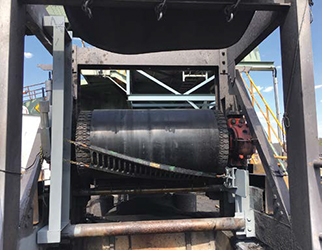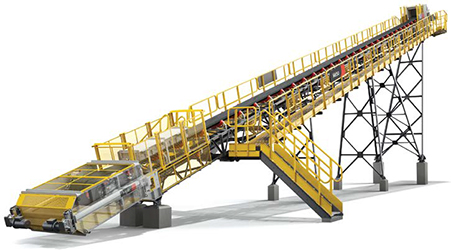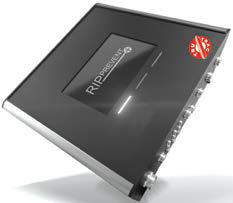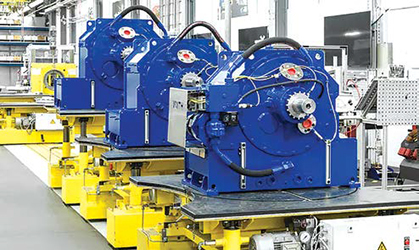
Weba Chute Systems uses a customized approach to each chute’s specific
application, modelling the flow of material to guide the final design.
(Photo: Weba Chute Systems)
Keeping Mining Conveyors Safe,
Speedy and Sustainable
New products, features and guidance from leading conveying experts
By Carly Leonida, European Editor

Martin Engineering:
Controlling Material
at Transfer Points
In mining operations, conveyor belts
form a critical path between extraction
and end-product, and they move bulk
materials through a process. Yet every
time there’s a transfer from one piece of
equipment to the next there’s also a risk
of those materials escaping, creating numerous
challenges.
In a recent thought leadership article, the team at Martin Engineering explained how best to deal with fugitive material. “Fugitive material, whether spilling on the deck, clogging the production process or pumping into the air, presents multiple health and safety risks. For instance, spillage increases the risk of slips, trips and falls while exposure to airborne dust can pose long-term health risks,” the team said.
If spillage is left to accumulate, it will start interfering with production, from conveyor belt mis-tracking and damage to seized components, structural problems and total process failure. Sending in workers to clean up manually is still the norm. This can expose people to working in confined spaces or at height and can put them at risk of stored energy releases, entrapment, falling materials and manual handling.
Despite what we know about the importance of energy isolation through Lock Out, Tag Out, Try Out (LOTOTO) procedures, production pressures can that mean clean-ups take place while equipment is still running, and experience shows this can have catastrophic consequences. To address these challenges, conveyor equipment manufacturers have sought to design innovative components and solutions that can prevent fugitive dust and spillage from conveyors and transfer points.
Daniel Marshall, product engineer at Martin Engineering, said: “When tons of bulk material hit a moving conveyor belt, three things can happen: fines scatter in random directions, cargo shifts, and dust becomes airborne. The impact creates turbulent air pressure inside the chute that seeks to escape from any gap it can find, carrying dust and fines with it.
“A properly designed enclosure will manage bulk solids, allow cargo to settle in the center of the belt and contain most of the dust inside a settling zone enclosure. If left uncontained, fugitive material in the form of dust and fine particle spillage will increase labor costs for clean-up, foul equipment, potentially encapsulate the belt and pose a serious safety hazard.”

In contrast, well-designed conveyor loading zones keep walkways clear from spillage and keep dust emissions under control, allowing for hazard-free manual inspections and maintenance. According to Martin Engineering, well-designed loading zone typically consists of the following components: 1. An enclosed transfer chute long enough to give dust and fines time to settle. 2. A heavy-duty belt support system to absorb impact, protect the belt and handle rapidly shifting heavy material. 3. Closely spaced idlers to reduce sag in the belt that allows gaps where fines can escape and to ease material disruption from bouncing. 4. Externally adjustable or self-adjusting skirting that’s able to contain fine particles and adapts to fluctuations in the belt plane. 5. Easily serviced external wear liners that can be inspected and changed from outside the chute without confined space entry. 6. Dust curtains set strategically throughout the enclosure to control airflow and help settle dust. 7. Dust bags or mounted air cleaners to collect tiny, highly active particles. 8. A sealed tail box to protect the tail pulley from the backflow of fines, dust and spillage. 9. Exit curtains to prevent fugitive dust from escaping from the end of the chute.
Primary and secondary conveyor belt cleaners also play a role in ensuring belts are kept clean and in preventing material carryback, spillage and build-up after the point of discharge. But to be effective, belt cleaner blades must be in constant contact with the belt at the right tension. And it’s the inspection, servicing, re-tensioning and replacement of belt cleaners that can give rise to transfer point health and safety risks.
To meet the demands for greater safety and improved production, Martin Engineering has designed a family of heavy-duty conveyor belt cleaners that allow the blade cartridge to be slid away from the belt for safe access. The system enables all servicing to take place outside of the chute, reducing the risk of injuries associated with moving machinery — manual handling, confined spaces and difficult access — and keeps workers away from harm while servicing belt cleaners. The design also enables blades to be serviced and replaced by a single worker in a fraction of the time of a typical blade replacement task.
The same slide-out technology has been applied to impact cradle designs. The systems are engineered so operators can work on the equipment safely, without breaking the plane of motion. Another way to reduce exposure to risk during maintenance and ensure good belt cleaning performance, is by using a belt cleaner design that doesn’t feature a urethane blade. For example, CleanScrape from Martin Engineering is equipped with tungsten carbide tips that deliver extended service life, low belt wear, significantly reduced maintenance and improved safety. Unlike conventional belt cleaners that are mounted horizontally across the belt plane, this cleaner is installed diagonally across the discharge pulley, forming a three-dimensional curve beneath the discharge area that molds to the pulley’s shape.

“The smart thing about this kind of innovation is that it goes straight in at the top of the health and safety ‘hierarchy of controls,’ eliminating needless inspection visits and significantly reducing the interaction between people and conveyors. Technicians only need to visit conveyors when the system shows that a belt cleaner needs attention, often this can be planned for an already scheduled shutdown.”
The result is a remote monitoring system that tracks the condition of each blade. It features a position indicator — a polyurethane collar embedded with a wireless sensor unit — fitted to each primary belt cleaner. The sensor unit transmits data on blade wear life to a central on-site ‘gateway’ device which sends the information to the cloud. From there users can access belt cleaner condition data in one place on an easy-to-use mobile app or desktop dashboard which predicts the re-tensioning cycle for each belt cleaner and indicates when servicing should be scheduled or performed immediately.
The N2 Position Indicator is a polyurethane collar embedded with a sensor unit that fits onto the end of the belt cleaner mainframe. Harasym said: “It’s the ideal solution, especially for large-scale plants which have numerous difficult-to-access belt conveyors distributed over a large production site. The next generation of innovation to make bulk materials processing safer and more efficient is here.”
Metso Launches FIT and
Foresight Overland
Conveyors
In April 2024, Metso launched its
modular FIT and Foresight overland
conveyors which offer fast set-up and
increased productivity in mining applications.
The standardized conveyor
modules and premium components
offer high capacity and layout flexibility
as well as substantial savings in time
and resources, from feasibility and
design to implementation, thereby enabling
higher lifetime productivity.
The high-capacity Metso Foresight
overland conveyors are fixed or relocatable
and connect the primary crushing
station with the coarse ore stockpile. The
Metso FIT in-plant conveyors are compatible
with Metso FIT crushing plants
that are designed for the most demanding
mining applications.
“The modular FIT and Foresight conveyors take project ease, speed and productivity to the next level,” said Guillaume Lambert, senior vice president, crushing at Metso. “We have designed these conveyors for easier planning, configuration, installation and maintenance with a wide range of modules and components. This enables our mining customers to get their in-plant and overland conveying systems up and running faster and brings a quicker return on investment.
“Thanks to the standardized modular design of the conveyors, we have been able to shorten delivery time by up to 25% and set-up time by up to 15%. Metso premium components are used in the conveyors, and the use of Convey- Insights predictive maintenance and flow control technology can help our customers achieve their productivity targets.”
To improve the feasibility study process on Foresight overland conveyors, Metso developed the William Conveyor Explorer, an application software that is connected to its conveyor module range and can be found in the new Metso Crush and Convey Resource Center.
With the new application, mining and EPC/M customers can enter their process and route data and then instantly assess multiple conveying options and download the modules they need for efficient planning in their software environment. This development also supports mine electrification programs to reach fast decarbonization plans and targets.
Motion Introduces CM
Battery Star Hoist
Motion Conveyance Solutions recently
added the CM Battery-Star — a 1-ton battery
powered chain hoist from Columbus
McKinnon — to its conveying offering.
This can be used effectively in remote or
confined spaces where there is no other
power source to lift pumps, motors and
other replacement parts during the inspection
and repair of mine conveyors.

The hoist can be used in either typical mounting orientation with the hoist body attached to the anchor point or inverted, eliminating the need to lift the hoist up to the anchor point. The wireless remote keeps the operator safe and away from the load, allowing for operation from over 60-ft away from the hoist. The remote features built-in intelligence, alerting the operator with light-up icons if the hoist is overcapacity, low battery, or hoist inspection is due. Weighing less than 50 lb when 20-ft of chain is included, the Battery- Star is compact and lightweight for easy portability.
Purvis Industries:
Delivering Tailored
Conveying Solutions
With a diverse range of specialized business
units, Purvis Industries has the
capability to handle small-scale, customized
conveying projects through to major
plant expansions, ensuring seamless integration
of every component.
The company was recently contacted by a leading aggregate producer to assist in a full plant expansion. Leveraging its “Family of Companies” model, Purvis Industries brought together experts from across its divisions to provide a complete, integrated solution.
KMEC handled the design, preliminary engineering, and material handling equipment fabrication. Foresight Automation took on the automation, variable speed drives, motor control centers, e-houses, and other electrical equipment, while HydraAir provided the design for pneumatics and hydraulics systems, ensuring the seamless operation of slide gates and diverters. Working with IMSCO Technical and a trusted construction partner, Purvis was able to streamline the project, making it a single-source provider for the entire expansion. In addition, CapCorp handled the field vulcanization of belts for all the belt conveyors required.
KMEC specializes in creating custom- built bulk material handling solutions tailored to clients’ needs. As part of another project, the company supplied a tubular stacker designed and manufactured at its Houston, USA, facility. The stacker, measuring 12-ft in diameter and 160-ft in length, featured dual walkways and a 42-in. wide belt conveyor. It is capable of stacking 250-metric tons per hour (mt/h) of material and can slew 45° across the pile. KMEC is dedicated to delivering solutions that meet customers’ individual requirements, on schedule and within budget.
Superior’s Enhanced Conveyor Impact Cradle
In August 2024, Superior Industries unveiled
a revised design of its popular
Conveyor Impact Cradle. The new and
improved arrangement includes larger
pad cartridges to enhance durability and
a reinforced point of connection between
the pads and cradle frame.
According to Superior’s engineers, the Conveyor Impact Cradle is a modern redesign of the traditional impact bed. While both products absorb the force of falling material to prevent damage to conveyor belts, the Impact Cradle is specifically engineered to address common shortcomings associated with the design of traditional impact beds. For instance: • It’s curved bed fully supports belting, leaving no gaps to trap fugitive material. • Pads are easy to slide on or off cradle frame in tight, hard to access transition zones. • No special tools are required, which speeds installation and maintenance. • Features one-piece pads made from a special urethane to reduce friction and enhance cushioning.
In addition to these redesigned features, Superior’s Impact Cradle is available in two more pre-engineered models: medium and heavy-duty are now available in addition to the standard model, which was first introduced to conveyor owners in 2017.
Tru-Trac Launches Rip Prevent+ at Electra
Tru-Trac unveiled the Rip Prevent+ system
at Electra Mining Africa in August 2024. This advanced monitoring technology
detects and addresses conveyor
belt issues early to reduce downtime and
boost efficiency in mining and materials
handling operations.
The Tru-Trac Rip Prevent+ system, which is now available in Africa, allows mines to optimize their conveyor line performance by preventing costly interruptions due to rip events. Using a data- driven model and AI, Rip Prevent+ can detect anomalies or rip events on any conveyor belt type, including metal cord, pipe and fabric belts.

By stopping the conveyor belt when a possible rip event is detected, the system minimizes associated damage, potentially saving millions of dollars in downtime, belt replacement, and cleanup costs. Tru-Trac said the system’s data-driven model offers significant advantages over inductive, magnetic and laser-based systems, including reduced wear risk, suitability for all conveyor types and lower investment costs.
The Rip Prevent+ system is webbased and accessible via an Ethernet network connection, featuring a user- friendly interface with a dashboard displaying key information. Additionally, the system incorporates several functions beyond rip detection, including mass flow calculation, condition monitoring, drive or motor monitoring, energy efficiency and electrical network analysis, aligning with predictive maintenance strategies.
Tru-Trac said that Rip Prevent+ is easy to install, requiring only 30 minutes to an hour, with minimal downtime for electrical connections. Commissioning the system can be completed within two to five hours, depending on preparatory work and available system parameters. Notably, Rip Prevent+ is the first rip detection system based on a subscription model to minimize capital investments.
Voith Makes Fluid Couplings More Sustainable
Voith’s latest advancement in its portfolio
of constant-fill fluid couplings is Sustainable
T. The company’s hydrodynamic fluid couplings have been fixtures in many
industries — including mining — for decades.
They are used wherever maximum
reliability, even in extreme environmental
conditions, is demanded of equipment.
Thanks to their robust design, the couplings provide efficient production flows in mining systems, especially belt conveyors, crushers, impactors, separators and mixers. They are also used in port facilities, construction machines and equipment, pumps and compressors, and a wide variety of other industrial drive systems.

It is only a matter of time before the requirements for processing, disposal and recycling will be tightened further in the interests of better environmental protection and health, according to Hilka. For customers, these innovations bring with them further advantages. For instance, products that do not contain hazardous substances do not have to be handled or disposed of separately later. “As a result, we save our customers unnecessary concerns and unforeseen costs,” Hilka emphasized.
One of the innovative functional improvements of Sustainable T is the design of the fusible plug, which Voith has optimized and patented. It provides savings of up to 70% compared with the competition in terms of the amount of fusible alloy material used. At the same time, the response behavior of the plug is improved, and Voith avoids using hazardous materials, such as lead or cadmium in the slug. This is better for both people’s health and the environment.
The same applies to the use of new, more sustainable hydraulic fluids made possible through the advancements within the scope of Sustainable T. “Our constant- fill fluid couplings are made in such a way that customers can use selected hydraulic fluids that are readily biodegradable,” Hilka pointed out. Voith also offers the option of using an alternative to the mineral oil that has been commonly used to date. “In this way, we make it possible to operate our couplings more sustainably without compromising on quality. Our customers can continue to rely on the familiar reliability and long service life of our fluid couplings,” said Hilka.
Other advancements in the water-operated couplings from Voith also contribute to sustainability. For example, the couplings can now be operated with a mixture of water and selected antifreeze agents. The materials of the components can be selected for use down to -40°C if necessary. Until now, operators at locations at which temperatures could drop below freezing had to use mineral oil-filled couplings. This is a particular advantage for equipment operating in sensitive environments.
Weba: Keeping Chutes Working When Speeding Up Conveyors
In mining environments, chutes are
generally designed to manage some
variance in the loads being transported
by conveyor systems, but drastic
changes in conveyor belt speeds can
introduce complications.
According to Dewald Tintinger, Technical Manager at Weba Chute Systems, chutes are designed with the width of the conveyor belt in mind, accommodating the various levels of loading on these belts. However, changing the speed of the belt significantly can affect not only the volume of material entering the chute, but the first point of contact in the chute as the material leaves the belt.
“The speed of the conveyor belt has a direct impact on the trajectory of material when it reaches the chute,” said Tintinger. “When changing the belt speed from 2.5-m/s to 3-m/s, for example, the chute would easily accommodate this. However, if the speed was doubled, this would change the trajectory so that the material impacts a different point in the conveyor, and at a different angle.”

“As the impact angle approaches 90°, there’s a risk that material flow could stall,” he said. “Rather than slowing down on impact and then accelerating downward towards the discharge point, the material could start backing up and clog the chute.” While some chute manufacturers introduce platework to bend the trajectory of material, this adds to the wear on the chute. Weba Chute Systems generally applies its full cascade designs, using dead box sections to reduce the impact and speed.
“The change of angle of material onto the first dead-box will not necessarily change the flow pattern, but it is likely to affect the speed of material through the chute,” says Tintinger. “It’s therefore important to check the chute’s capacity to still allow enough material to pass through smoothly.”